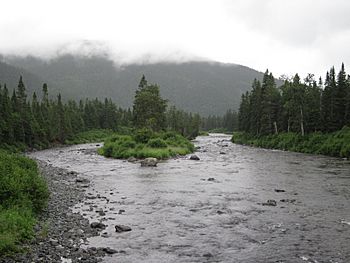Cascapédia River facts for kids
Quick facts for kids Cascapedia River |
|
|---|---|

Cascapédia River in the Gaspésie Park
|
|
| Other name(s) | Rivière Cascapédia |
| Country | Canada |
| Province | Quebec |
| Region | Bas-Saint-Laurent, Gaspésie |
| Physical characteristics | |
| Main source | Lake Cascapédia Mont-Albert UNO 490 m (1,610 ft) 48°54′22″N 66°20′58″W / 48.90611°N 66.34944°W |
| River mouth | Cascapedia Bay (Chaleur Bay) Gesgapegiag 0 m (0 ft) 48°11′13″N 65°54′44″W / 48.18694°N 65.91222°W |
| Length | 120 km (75 mi) |
| Basin features | |
| Basin size | 3,172 km2 (1,225 sq mi) |

The Cascapédia River is a beautiful river located in the Gaspé Peninsula of Quebec, Canada. It begins at Lake Cascapedia, fed by streams flowing from the Chic-Choc Mountains. The river then travels about 120 kilometres (75 mi) before it flows into Cascapedia Bay, which is a small part of Chaleur Bay. Sometimes, people call it the Grand Cascapédia River to tell it apart from a smaller river nearby.
This river is very famous for its amazing Atlantic salmon fishing. The salmon caught here are often quite large, averaging about 20 pounds (9.1 kg). The biggest salmon ever caught in the river was an incredible 54 pounds (24 kg) in 1886! Because of these huge fish, the Cascapédia River has been known for a long time as one of Quebec's best salmon rivers. Even back in 1835, a surveyor named Joseph Hamel noticed how many fish, like salmon and trout, lived in the river. Some important people, like past Governors General of Canada, even had summer homes along this river.
You can reach the river by using Quebec Route 299, a road that follows the river for 69 kilometres (43 mi). Most of the river's path is protected within the Cascapedia River Wildlife Reserve. This special area was created in 1982 to help keep the river and its wildlife safe. The very beginning of the river and Lake Cascapedia are found inside the Gaspésie National Park.
What's in a Name?
The name Cascapédia comes from the Mi'kmaq language. The Mi'kmaq people are an Indigenous group from this area. The word gesgapegiag means "strong current" or "large river."
The name of the river has changed a bit over time. It first appeared on a map in 1686 as Kichkabeguiak. Later, in 1783, it was shown as Kaskabijack on another map. By 1863, the spelling we use today, Cascapédia, became common.
Why the Water is So Clean
The Cascapédia River is special because it is completely wild and has no dams. No towns or cities use it for their wastewater, which means it stays very clean.
The river's source is in the Chic-Choc Mountains. These mountains have a lot of limestone, which is a type of rock that dissolves easily. Because of this, the river's water is rich in natural minerals called carbonates. It also has very low levels of other chemicals like sulfates and chlorides. This makes the water have a higher conductivity and pH level than typical rivers in the Canadian Shield area.
There isn't much farming or industry around the river, which helps keep it free from pollution. Because of all these factors, the water in the Cascapédia River is considered to be of the highest quality.
River's Surroundings
The land around the Cascapédia River is mostly untouched. Less than 500 hectares (1,200 acres) of the area is used for farming. Logging, which is cutting down trees, is more common. Between 1988 and 1994, about 8 percent of the land around the river was used for logging.

